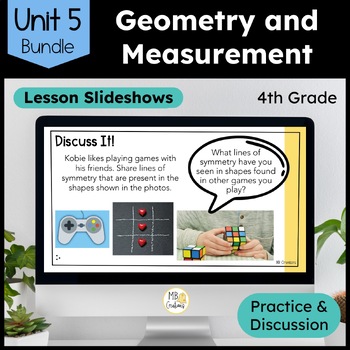Geometry, Angle Measurement, Symmetry Unit 5 PowerPoints 4th Grade iReady Math
- Zip
- Easel Activity
Products in this Bundle (5)
Bonus
Also included in
- Teaching 4th-grade students about geometry and measurement with iReady Classroom Math requires a great deal of practice. Implement these PowerPoint slides, exit tickets, worksheets, and vocabulary activities into your iReady Math routines. This bundle provides extra instruction and practice for studPrice $32.40Original Price $39.75Save $7.35
- Use this yearlong 4th-grade math curriculum to teach common core standards with the help of lesson presentations, math worksheets, and exit tickets. Whether you teach iReady Math or another curriculum, these print and digital problems about place value, operations, fractions, and geometry and preparPrice $179.90Original Price $270.00Save $90.10
Description
Present these extension slideshows about geometry, angles, and symmetry to supplement 4th-Grade iReady Math skills. These ready-to-use PowerPoint slides extend upon iReady Classroom Math lessons by giving students more practice with measuring angles and drawing lines of symmetry. Plus, choose your favorite platform! Upload to Google Slides, assign in Google Classroom, or share a TPT Easel link. Increase interaction with the use of PearDeck and Nearpod applications. Image files are also included so you can drop into SeeSaw and help your students excel.
iReady Classroom Math 4th Grade - Unit 5 Lessons:
- 30 - Points, Lines, Rays, and Angles
- 31 - Angles
- 32 - Add and Subtract with Angles
- 33 - Classify Two-Dimensional Figures
- 34 - Symmetry
Check out the Contents of Unit 5 - Geometry, Angles, and Symmetry:
✏️ Practice Problems for Each Session (4 Try It, 1 Discuss It, 1 Connect It)
✏️ Lesson Objectives Slide
✏️ Math Vocabulary Slides (Introduce new math terms, review terms, and practice/discuss terms)
✏️ Reflection Slides - Evaluate if students understand the lesson concept and make learning visible!
✏️ Answer Keys
Save time and energy by implementing these slideshow presentations into your iReady Classroom Math routines. This resource provides extra instruction for students as they discuss mathematical thinking and make connections to real-world problems. These rigorous math activities align with Common Core State Standards and prepare students for standardized testing.
Teach students about geometry, angles, and symmetry with this math presentation!
✅ Present the slides before teaching an iReady Classroom Math lesson to preteach math concepts.
✅ Share this presentation after a math lesson to extend the topic and deepen students' learning.
✅ Use Pear Deck or Nearpod to increase engagement as students respond to questions.
✅ Present during small groups to help students draw and measure angles.
Hear About This Math Slideshow From Educators Like You!
⭐️ “Absolutely love these products. They give my students the extra practice that was missing.
⭐️ “A true life-saver for those who are using iReady in the classroom and need a little something more!”
⭐️ “The problems are similar to what you would find in iReady, but there are problems that give students a little more of a challenge, which is what I like. Great resource.”
⭐️ “This has made teaching iReady Math so much easier and I love how it goes over vocabulary, too!”
Find Answers to Your Questions About These Math Slides:
✋ Does my district have to use iReady Classroom Math (published in 2020)?
- No, these PowerPoint presentations align with CCSS and provide excellent practice to students in all math classes. Don’t take my word for it… teachers like you have said, “This was awesome! I LOVE the range of problem types! My school doesn’t use iReady and I still LOVED these slides!”
✋ How is this resource different from the practice worksheets and exit tickets?
- This resource provides additional instruction questions as students try problems, discuss math, and connect concepts. All of the problems come in a PowerPoint slideshow. You can also drag and drop image files into OneNote, Seesaw, etc. In contrast, the 4th-grade practice worksheets and exit tickets can be printed and given to students as independent work or homework. They come in print and digital formats. I use both resources in my classroom.
Did you know? You can assign TPT Easel resources, like this lesson on how to draw and measure angles, to Google Classroom or share through a link!
#mbcreations #mbcreations4education #ireadymath
❤️Follow me to receive updates on new resources. ❤️
⬇️ Yearlong 4th Grade iReady Math Collection: ⬇️







